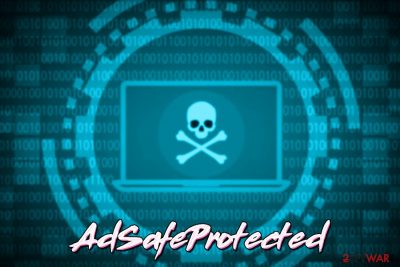AdSafeProtected (Removal Guide) - Aug 2021 update
AdSafeProtected Removal Guide
What is AdSafeProtected?
AdSafeProtected is the domain used by various companies that focus on the advertisement delivery

AdSafeProtected is a potentially unwanted application[1] that usually gets installed on the system with the help of shareware and freeware, as users often skip steps while establishing new programs and do not read the text in the fine print. The app typically delivers intrusive material to expose the user to other sites that can trigger malware infiltration. Internet browsing activities also get affected by data tracking and other intrusive behavior like pop-up delivery and reroutes.
Adware's primary purpose is to display pop-ups, offers, deals, banners, and other advertisements on Google Chrome, Internet Explorer, Mozilla Firefox, or Safari browsers. While the virus is prominent on Mac, Android, and Windows users are also known to suffer from it. Additionally, users reported that Doubleclick ads often link to Pixel.adsafeprotected.com or fw.adsafeprotected.com domains. Without a doubt, adware should not be kept on any system to maintain its security.
| Summary | |
| Name | AdSafeProtected |
| Type | Adware, potentially unwanted program |
| Subdomains | anycast.fw.adsafeprotected.com, dt.fw.adsafeprotected.com |
| Infiltration | Software bundling |
| Main dangers | Malware infection |
| Main purpose | To generate ad revenue |
| Elimination | Use our instructions below or employ anti-malware software |
| Optimization | To make sure all the traces are deleted and the computer is back to normal, scan it with FortectIntego |
AdSafeProtected has been actively bugging users in order to earn profits from ads. Unfortunately, adware related to it is unsafe, as it could track user data, redirect them to scam or phishing sites, or even lead to sites loaded with malware. For that reason, victims should not click on any content that is initiated by the PUP and take care of the threat removal as soon as possible.
Users also reported that they are receiving pop-up windows that load a script for a while, coming out with nothing. In some cases, intrusive ads prevent them from viewing videos or similar content. To accumulate enough data about users, AdSafeProtected adware uses tracking technologies like cookies, web beacons,[2] and JavaScript. With the help of these tools, the affected users' information can be gathered:
- IP address;
- Technical data;
- Programs installed;
- Bookmarks;
- Search data;
- Sites visited, etc,
While many companies use tracking technologies for marketing purposes, experts[3] do not advise trusting adware-relating programs. The data harvested can be potentially misused and end up in the hands of cybercriminals. As soon as that happens, credit card details and other personal data can serve as a tool for identity fraud or money stealing. Thus, if you see ads that link you to AdSafeProtected, make sure you do not enter any sensitive information.
You are not safe until you remove the virus from your computer. You can do it with the help of anti-malware software that is capable of detecting PUPs or follow our removal instructions below this article. For the elimination, make sure you employ SpyHunter 5Combo Cleaner or Malwarebytes to avoid the damage done by the unwanted program.

Avoid pre-packed pieces by paying enough attention to installation processes
If you encounter a redirect to a questionable website, do not click on anything and simply close down the tab. However, if you are regularly being rerouted to questionable domains, it is a sign of an adware infection.
If you are wondering where the potentially unwanted program could have come from, you should check if you recently installed any free applications you downloaded online. Third-party websites like Download.com[4] or Cnet are some of the biggest providers of installers that are plagued with useless apps and often hidden purposely. By “hidden,” we don't mean that optional installs are not accessible or impossible to decline – it is not the case.
Installing something on user's machine without informing him or her about it is illegal, hence why malware distribution is considered to be criminal activity. However, PUP authors often hide legal documents, regulations, and a full list of programs by urging users to go for Recommended or Quick settings, and, most people do.
For that reason, picking Advanced or Custom installation settings is a must. This will let you uncover all the hidden components, and get rid of the pre-checked boxes.
To remove the intruder you need to clear the AdSafeProtected related content from web browsers
We recommend users not to waste time and remove the intrusive virus either by using security software or rely on our manual instructions below. Both methods are effective, although the latter might take quite a bit longer. AdSafeProtected removal should not be delayed, as adware multiplies fast. Quite often, these dubious applications are closely related and promote unsafe system tools for users to download.
Software like scareware is very typical for adware to promote, so users end up with cluttered systems without even realizing that they are injecting more unwanted apps into their machine. After AdSafeProtected elimination from Mac or Windows operating systems is complete, reset each of the installed browsers as explained in the instructions below.
You may remove virus damage with a help of FortectIntego. SpyHunter 5Combo Cleaner and Malwarebytes are recommended to detect potentially unwanted programs and viruses with all their files and registry entries that are related to them.
Getting rid of AdSafeProtected. Follow these steps
Uninstall from Windows
Instructions for Windows 10/8 machines:
- Enter Control Panel into Windows search box and hit Enter or click on the search result.
- Under Programs, select Uninstall a program.

- From the list, find the entry of the suspicious program.
- Right-click on the application and select Uninstall.
- If User Account Control shows up, click Yes.
- Wait till uninstallation process is complete and click OK.

If you are Windows 7/XP user, proceed with the following instructions:
- Click on Windows Start > Control Panel located on the right pane (if you are Windows XP user, click on Add/Remove Programs).
- In Control Panel, select Programs > Uninstall a program.

- Pick the unwanted application by clicking on it once.
- At the top, click Uninstall/Change.
- In the confirmation prompt, pick Yes.
- Click OK once the removal process is finished.
Delete from macOS
Remove items from Applications folder:
- From the menu bar, select Go > Applications.
- In the Applications folder, look for all related entries.
- Click on the app and drag it to Trash (or right-click and pick Move to Trash)

To fully remove an unwanted app, you need to access Application Support, LaunchAgents, and LaunchDaemons folders and delete relevant files:
- Select Go > Go to Folder.
- Enter /Library/Application Support and click Go or press Enter.
- In the Application Support folder, look for any dubious entries and then delete them.
- Now enter /Library/LaunchAgents and /Library/LaunchDaemons folders the same way and terminate all the related .plist files.

Remove from Microsoft Edge
Delete unwanted extensions from MS Edge:
- Select Menu (three horizontal dots at the top-right of the browser window) and pick Extensions.
- From the list, pick the extension and click on the Gear icon.
- Click on Uninstall at the bottom.

Clear cookies and other browser data:
- Click on the Menu (three horizontal dots at the top-right of the browser window) and select Privacy & security.
- Under Clear browsing data, pick Choose what to clear.
- Select everything (apart from passwords, although you might want to include Media licenses as well, if applicable) and click on Clear.

Restore new tab and homepage settings:
- Click the menu icon and choose Settings.
- Then find On startup section.
- Click Disable if you found any suspicious domain.
Reset MS Edge if the above steps did not work:
- Press on Ctrl + Shift + Esc to open Task Manager.
- Click on More details arrow at the bottom of the window.
- Select Details tab.
- Now scroll down and locate every entry with Microsoft Edge name in it. Right-click on each of them and select End Task to stop MS Edge from running.

If this solution failed to help you, you need to use an advanced Edge reset method. Note that you need to backup your data before proceeding.
- Find the following folder on your computer: C:\\Users\\%username%\\AppData\\Local\\Packages\\Microsoft.MicrosoftEdge_8wekyb3d8bbwe.
- Press Ctrl + A on your keyboard to select all folders.
- Right-click on them and pick Delete

- Now right-click on the Start button and pick Windows PowerShell (Admin).
- When the new window opens, copy and paste the following command, and then press Enter:
Get-AppXPackage -AllUsers -Name Microsoft.MicrosoftEdge | Foreach {Add-AppxPackage -DisableDevelopmentMode -Register “$($_.InstallLocation)\\AppXManifest.xml” -Verbose

Instructions for Chromium-based Edge
Delete extensions from MS Edge (Chromium):
- Open Edge and click select Settings > Extensions.
- Delete unwanted extensions by clicking Remove.

Clear cache and site data:
- Click on Menu and go to Settings.
- Select Privacy, search and services.
- Under Clear browsing data, pick Choose what to clear.
- Under Time range, pick All time.
- Select Clear now.

Reset Chromium-based MS Edge:
- Click on Menu and select Settings.
- On the left side, pick Reset settings.
- Select Restore settings to their default values.
- Confirm with Reset.

Remove from Mozilla Firefox (FF)
Remove dangerous extensions:
- Open Mozilla Firefox browser and click on the Menu (three horizontal lines at the top-right of the window).
- Select Add-ons.
- In here, select unwanted plugin and click Remove.

Reset the homepage:
- Click three horizontal lines at the top right corner to open the menu.
- Choose Options.
- Under Home options, enter your preferred site that will open every time you newly open the Mozilla Firefox.
Clear cookies and site data:
- Click Menu and pick Settings.
- Go to Privacy & Security section.
- Scroll down to locate Cookies and Site Data.
- Click on Clear Data…
- Select Cookies and Site Data, as well as Cached Web Content and press Clear.

Reset Mozilla Firefox
If clearing the browser as explained above did not help, reset Mozilla Firefox:
- Open Mozilla Firefox browser and click the Menu.
- Go to Help and then choose Troubleshooting Information.

- Under Give Firefox a tune up section, click on Refresh Firefox…
- Once the pop-up shows up, confirm the action by pressing on Refresh Firefox.

Remove from Google Chrome
Delete malicious extensions from Google Chrome:
- Open Google Chrome, click on the Menu (three vertical dots at the top-right corner) and select More tools > Extensions.
- In the newly opened window, you will see all the installed extensions. Uninstall all the suspicious plugins that might be related to the unwanted program by clicking Remove.

Clear cache and web data from Chrome:
- Click on Menu and pick Settings.
- Under Privacy and security, select Clear browsing data.
- Select Browsing history, Cookies and other site data, as well as Cached images and files.
- Click Clear data.

Change your homepage:
- Click menu and choose Settings.
- Look for a suspicious site in the On startup section.
- Click on Open a specific or set of pages and click on three dots to find the Remove option.
Reset Google Chrome:
If the previous methods did not help you, reset Google Chrome to eliminate all the unwanted components:
- Click on Menu and select Settings.
- In the Settings, scroll down and click Advanced.
- Scroll down and locate Reset and clean up section.
- Now click Restore settings to their original defaults.
- Confirm with Reset settings.

Delete from Safari
Remove unwanted extensions from Safari:
- Click Safari > Preferences…
- In the new window, pick Extensions.
- Select the unwanted extension and select Uninstall.

Clear cookies and other website data from Safari:
- Click Safari > Clear History…
- From the drop-down menu under Clear, pick all history.
- Confirm with Clear History.

Reset Safari if the above-mentioned steps did not help you:
- Click Safari > Preferences…
- Go to Advanced tab.
- Tick the Show Develop menu in menu bar.
- From the menu bar, click Develop, and then select Empty Caches.

After uninstalling this potentially unwanted program (PUP) and fixing each of your web browsers, we recommend you to scan your PC system with a reputable anti-spyware. This will help you to get rid of AdSafeProtected registry traces and will also identify related parasites or possible malware infections on your computer. For that you can use our top-rated malware remover: FortectIntego, SpyHunter 5Combo Cleaner or Malwarebytes.
How to prevent from getting adware
Stream videos without limitations, no matter where you are
There are multiple parties that could find out almost anything about you by checking your online activity. While this is highly unlikely, advertisers and tech companies are constantly tracking you online. The first step to privacy should be a secure browser that focuses on tracker reduction to a minimum.
Even if you employ a secure browser, you will not be able to access websites that are restricted due to local government laws or other reasons. In other words, you may not be able to stream Disney+ or US-based Netflix in some countries. To bypass these restrictions, you can employ a powerful Private Internet Access VPN, which provides dedicated servers for torrenting and streaming, not slowing you down in the process.
Data backups are important – recover your lost files
Ransomware is one of the biggest threats to personal data. Once it is executed on a machine, it launches a sophisticated encryption algorithm that locks all your files, although it does not destroy them. The most common misconception is that anti-malware software can return files to their previous states. This is not true, however, and data remains locked after the malicious payload is deleted.
While regular data backups are the only secure method to recover your files after a ransomware attack, tools such as Data Recovery Pro can also be effective and restore at least some of your lost data.
- ^ Potentially Unwanted Application. Trend Micro. Security Blog.
- ^ Web Beacon. Technopedia. Site that helps to understand technology.
- ^ SenzaVirus. SenzaVirus. Cybersecurity news and articles.
- ^ Lowell Heddings. Here’s What Happens When You Install the Top 10 Download.com Apps. How-To Geek. Site that explains technology.























